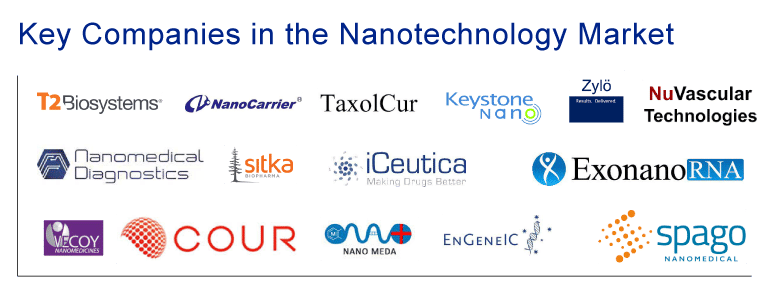Understanding How Emerging Applications of Nanotechnology are Upgrading the Healthcare Delivery?
Aug 24, 2022
Table of Contents
Nanotechnology is an evolving and innovative technology set to transform healthcare dynamics to its core with promising applications. Advancements in nanoscience have led to the emergence of a new generation of nanostructures that are employable in the healthcare industry to a much larger extent. With the unique ability and set of properties to be implemented at atomic levels, it is opening new doors of possibilities in the segment, such as diagnostics, genetic diseases, vaccine development, regenerative medicine, gene therapy, treatment of cancer, disease monitoring, surgical devices, and drug delivery, among others.
As of now, it is in its infancy state; it will presumably enhance the quality and affordability of the healthcare service to the general population with astonishing applications in the near future. In the long run, it will tremendously influence the healthcare industry and contribute to better health outcomes.
Downloads
Article in PDF
Recent Articles
- Navigating the Most Use Cases of Robotic Process Automation (RPA) in Healthcare
- Does the use of Assistive Technologies in Autism Spectrum Disorder Payoff?
- Medical Radiation Detection Devices: Essential Tools in Healthcare and Diagnostics
- Where Women Healthcare Stands
- DelveInsight’s Gene Therapy Reports: Launched
Over the past few years, several nanotechnology-based nanotherapeutics have already been approved by different healthcare agencies worldwide, including FDA, for clinical use. Most nanotherapeutic products are approved for the treatments for cancer, high cholesterol, autoimmune disease, fungal infections, macular degeneration, hepatitis, and other conditions. Moreover, several studies and research regarding nanomedicine use in pathogen detection, DNA structure probing, vaccinations, magnetic resonance imaging (MRI) contrast agents, fluorescent biological labels, protein identification, gene-delivery agents, and the separation of biological molecules and cells, and tissue engineering are going at a larger scale globally.
What is Nanotechnology, and how is it applied in healthcare?
Nanotechnology uses the nanoparticles (NPs), such as metal, metal oxide, semiconductor, organic, and inorganic nanoparticles, to exploit their properties for different applications. The nanoparticle’s size range from 1 to 100 nm, but in some cases, the size may vary according to the use. For example, in medicine, nanoparticle size may range from 5 to 250 nm. There are also some nanosystems that may exceed several micrometers in size, e.g., liposomes.
Nanotechnology can be created via different procedures such as conventional chemical production and green synthesis processes. The implementation of nanotechnology has already transformed industries such as consumer electronics to textile manufacturing and cosmetics to Automotive, and with each passing day, it unlocks new potential. The main advantage of using nanoparticles is that they have a very high surface area-to-volume ratio, making them more reliable, reproducible, and safe to use.
In the healthcare industry, nanoparticles lead to several dramatic improvements at the micro level due to their catalytic activity, chemical stability, thermal conductivity, and non-linear optical performance. The inclusion of nanotechnology and its allied nanocarriers/nanosystems in medicine is known as nanomedicine, a field that can bring numerous benefits in disease prevention, diagnosis, and treatment at the nano level. Incredibly small sizes facilitate nanoparticles and nanodevices to demonstrate unexplored properties and operations. The nanoparticles can be developed into nanosystems with the transformational changes in their shape, surface properties, and size, which can efficiently be utilized for imaging, diagnosis, and treatment of serious diseases such as cancer, as well as cardiovascular, ocular, and central nervous system-related diseases. Currently, several researchers are using nanoparticles to target tumors in drug delivery systems and improve medical imaging. Due to their unique properties, such as ease of production, low cost, and toxicity, bio-inspired NPs hold an edge over traditionally produced particles/molecules. The usage of nanoparticles can have several benefits. It directly targets the diseases or cells, so it ultimately reduces the frequency with which we have to take our medications
What are the Major Applications of Nanotechnology in Healthcare?
The use of nanotechnology in the healthcare industry is referred to as Nanomedicine. Nanomedicine in healthcare deals with a generation of substances on the nanoscale, i.e., at the atomic or molecular level. Nanomedicine in healthcare can include many applications, including biosensors, tissue engineering, diagnostic devices, and many others. It performs a function on the same scale as many biological processes, cellular mechanisms, and organic molecules and provides an especially promising approach. Nanomedicine is developed to perform specific tasks and has a very narrow scope for side effects. Nanotherapeutics have already been FDA-approved and are available for clinical use, including treatments for cancer, high cholesterol, autoimmune disease, fungal infections, macular degeneration, hepatitis, and many other conditions.
Nanotechnology in Healthcare can be broadly classified into Diagnostics/Medical Devices and Nanomedicine. Several global MedTech giants, startups, and pharmaceuticals are leveraging this technology in healthcare to provide better treatment and diagnostics options.
Some of the Major Applications of Nanotechnology in the Healthcare Industry Includes-
Nanobots for Medical Treatment and Diagnosis
A nanobot, or nanorobot, is basically a microscopically small robot with several unique properties. They are developed to carry out a very specific and programmed function and are about ~50–100 nm wide. A nanomanipulation device is used to assemble and develop Nanobots. These are designed to carry out the tasks such as drug delivery effectively.
A drug or therapy normally works through the entire body before they reach the disease-affected area. But the nanobots can deliver the drug to the targeted area, which would make the drug much more effective and reduce the chances of possible side effects. Globally, more than 50+ nanomedicine formulations have been approved for clinical use, and several are in the pipeline and are expected to enter the market in the coming years.
Apart from drug delivery, nanobots have the potential in the surgical segment. Nanobots can be miniaturized and introduced into the body through the vascular system or at the end of catheters into various vessels and cavities. These Nanobots can be programmed to perform specific procedures autonomously or can be controlled from outside the body in-coordinated by an onboard computer. Nanobots can redefine the capabilities to perform precise and refined intracellular surgery. Moreover, they can perform functions such as searching for pathology, scraping plaque from arteries, detecting cancer cells, and removing or correcting the lesion.
Nanobots are becoming a major tool for health diagnostics as well. In the case of diagnosis, Nanoparticles can be used to increase the capabilities of devices such as ultrasound and MRI. The ongoing research, rapid development activities, and technological innovations are expected to extend new possibilities for Nanobots in the healthcare market.
Nanofibers
Nanofibers can be developed from different polymers with diameters ranging from a few tens to 1000 nm spun with either natural or synthetic fibers and from their composites with inorganic materials. Nanofibers are lightweight with a small diameter and have controllable pore structures that provide a high surface-to-volume ratio. These Nanofibers are being developed with electrospinning, also called electrostatic spinning. Nanofibers are formed from the polymer jet that undergoes stretching before solidification. Nanofibers can exhibit a wide range of physical properties that can be used for many potential applications such as filtration, sensors, protective clothing, tissue engineering, functional materials, and energy storage.
Made from biocompatible or biodegradable materials, the Nanofibers have unique properties and intrinsic functionalities such as improved drug solubility, increased porosity, exceptional mechanical strength, and versatile surface functionalization. They can be further used as dressings (wound healing) and potential drug delivery carriers. Nanofibers can be employed as ultrasensitive biosensors for point-of-care diagnosis of cancer, detection of circulating tumor cells in cancer patients, diagnosis of malaria, and detection of urea, glucose, cholesterol, bacteria, etc.
Similarly, companies are working on designing smart nanofibers that can respond to changes in the body’s vital stats due to superior micro and macro counterparts composed of the same materials. These smart nanofibers possess unique properties and fabrication techniques that can release the drug in response to stimulants such as pH and temperature in the body. Additionally, they can notice responses to biosensors, magnetic fields, ultrasound waves, enzymes, and light. Currently, several research studies are going on to assess the further use of smart nanofibers’ in the biomedical and healthcare fields, including on-demand drug release systems, medical implants, tissue-engineered scaffolds, and skin care.
Nanotech-based Wearables
Wearables are getting significant attention from the younger generation due to several benefits, such as comfort and monitoring health & well-being on a real-time basis. Technological development such as the internet of things (IoT) and high-speed Internet connectivity is leading to the growth of wearable electronic devices. Wearables monitor the strain, pressure, temperature, other external stimuli, and human motion to provide critical health or physiological information about the person’s health. Clothes, glasses, and watches are some of the most common wearables, and they can be directly attached to human skin to collect physical, chemical, and biological signals generated by the body change or their surroundings. Day by day, technologies are widening remote health care monitoring and human-machine interfaces.
Nanotech-based wearables come with sensors that are at par with diagnostics devices, can help detect various medical changes in the body, and can ultimately provide life-saving support. Nanotech-based wearables are segmented as bio-integrated devices, wearable health care systems, soft robotics, and electronic skins. Nanotech-based wearables use the nanomaterials and nanocomposites such as carbon nanotubes (CNT), silver nanowires, and graphene, which are integrated into clothing and accessories. Nanotechnology is expected to reduce wearables size while retaining functional capabilities and distinctions.
Currently, several of the key companies are actively working on Nanotech-based wearables. Nanowear, a US-based startup, launched the NanoSENSE study for its SimpleSENSE Device, a multi-sensor algorithm to predict Heart Failure in 2019. It aims to catch the biological inputs and sends alerts to doctors about congestive heart failure. Nanowear received its third FDA 510(k) clearance in September 2021 and first software-only clearance as an end-to-end digital platform, allowing the company to market a software-as-a-medical service that uses standalone artificial intelligence (AI) and deep learning algorithms to perform remote diagnosis.
Similarly, NanoEDGE is an interdisciplinary research project aiming at converging production techniques for functionalized electrodes with expertise in nanomaterial fabrication and characterization to produce multi-level sensors that can monitor health stats like electroencephalography (EEG) and electromyography (EMG). Due to intense innovation, technological transformation, and active participation of the tech giants, the Nanotech-based wearables electronics field has evolved rapidly during the past few years and is expected to grow significantly in the coming years as well.
Major Tech Giants and Startups in the Nanotech Healthcare Market
Currently, some of the major tech giants and startups, such as T2 Biosystems, Nanocarrier, TaxolCur, Keystone Nano, Nanomedical Diagnostics, Sitka Biopharma, iCeutica, Zylo Therapeutics, NuVascular Technologies, Vecoy Nanomedicines, Cour Pharmaceutical, Bio-Gate, Meda Biotech, EnGeneIC, ExonanoRNA, Nanoshell Company, Spago Nanomedical, Zylö Therapeutics, and others are actively working in the Nanotechnology Market. Owing to the rising investment and growing demand, several new players are expected to enter Healthcare Nanotechnology Market in the coming years.

Nanotechnology in Healthcare Market Dynamics
Nanomedicine is a promising application in the healthcare field. As per DelveInsight’s assessment, the Nanotechnology in Healthcare Market is expected to grow in the coming years owing to the ongoing research and development (R&D) activities in the Nanotechnology domain, growth in the healthcare infrastructure, rising investment, active participation of global MedTech giants, strategic partnerships and collaboration between companies, will significantly drive the Nanotechnology Market growth in the coming years.
Similarly, favorable policies by the healthcare agencies and government and the growing awareness & demand for advanced nanomedicines among patients suffering from cancer, cardiovascular, orthopedic, and chronic diseases will also influence the Nanotechnology market growth. Being expensive and high cost of development and difficulty in manufacturing are the key factors expected to hamper the growth of the Healthcare Nanotechnology Market.
Nanotechnology in Healthcare – Future Perspectives
Nanomedicine is bringing new possibilities to support the development of early diagnostic tools and better treatment options in the healthcare market. It is observed that more than 409 active or recruiting clinical trials are currently focusing on different therapeutics and diagnostics use of nanomedicines. Since the beginning of 2018, nearly 247 new clinical trials (active or recruiting) have been started, as reported in the National Library of Medicine (US).
The increasing investment, rising interest by the tech giants, and research activities in the Nanotechnology sector are providing momentum to nanomedicine growth. The ongoing innovation is expected to bring more exciting medical breakthroughs and overcome the existing challenge in treating complex diseases such as cancer, cardiovascular, neurodegenerative diseases, genetic disorders, and other illnesses.
Several nanomedicines and nanodiagnostics are already FDA-approved, and many more are in clinical trials and expected to hit the market in the near future. In the coming years, nanotechnology will significantly improve medical diagnostics and treatment scenarios which will be more effective and less expensive than the existing methods. It is set to broaden the healthcare outcome for a large section of society by fulfilling unmet medical needs.
Downloads
Article in PDF
Recent Articles
- Biosimilar Market in India
- Boston Biomedical starts phase III; Martindale receives approval; Merck snagged yes; Nanotechnolo...
- Interoperability Solutions in Healthcare – Evolving Market Dynamics and Improving Health Ou...
- Liquid Biopsy: Revolutionary Technique for Cancer Diagnosis
- Navigating the Most Use Cases of Robotic Process Automation (RPA) in Healthcare



